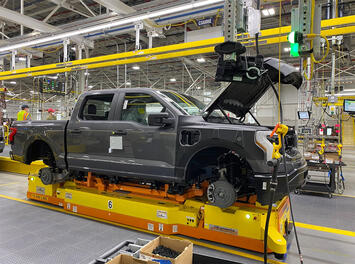
Ford is rapidly laying down the path to the future of the automobile, but in a strange way the new journey is wrapped in its past. That makes for a striking contrast — and promise — in Ford’s revolutionary strategy as the company accelerates production of its F-150 Lightning all-electric pickup truck in Dearborn, Michigan.
As I write for Chief Executive this week, a peek inside the Lightning factory like the one I got recently is jarring for a number of reasons. Instead of a traditional assembly-plant layout where conveyors lug around heavy and massive internal-combustion powertrains and ergonomically assisted assemblers place them in the chassis, the Lightning factory puts individual vehicles on skids called autonomous guided vehicles that simply glide from one cluster of workers to another. The Lightning powertrain is a bed of lithium-ion batteries that lies at the bottom of the machine.
The digital dashboard that workers use to track the manufacturing process looks like a really fun video game; ultimately, there will be no paper attached to each unit as it goes through the assembly process. Already, the largest collaborative robots in the world work side-by-side with human assemblers at the plant. The streamlining and flexibility involved in the plant layout and production process means that Ford can accomplish in 500,000 square feet at the Lightning plant what requires one million square feet at the adjacent plant where the company makes the traditional F-150.
More Than a Truck
And as Ford has begun allowing outsider access to the plant, managers manifest the most excitement when they demonstrate a capability of the Lightning that has nothing to do with historic truck attributes such as horsepower, payload or durability. They showcase how the new vehicle’s onboard electric generator can power up another vehicle or can alone keep an entire house lit up and even air-conditioned during, say, a grid outage.
“You can’t overestimate the importance of this,” Patrick Soderborg, Ford e-powertrain systems engineer, told my small tour. “There’s never been a system like this where you could use a truck to go help people.”
The other thing that gets plant denizens most juiced is showing off a “trunk” space in the front of the Lightning, under the hood where a traditional F-150 would have its engine. The huge compartment can handle up to 400 pounds of stuff and has a drain at the bottom in case owners want to use it as a cooler for a “frontgating” party.
Yet the repurposed space where Ford has begun to produce its paradigm-busting Lightning is literally ensconced in the bowels of the company’s century-old River Rouge complex a few miles from corporate headquarters. To get to the new plant that is upending decades of manufacturing, you’ve got to drive by and through a textbook full of American industrial history. “The Rouge” once was the largest integrated factory in the world. And it’s the site of the legendary “Battle of the Overpass” in 1937 in which United Auto Workers President Walter Reuther and his organizers were physically beaten by Henry Ford’s security forces.
“There’s history here, but there’s a new history we’re creating now,” said Chris Skaggs, planning and implementation manager at what’s known at the Rouge Electric Vehicle Center.
Read the rest of this piece at Flyover Coalition.
Dale Buss is founder and executive director of The Flyover Coalition, a not-for-profit organization aimed at helping revitalize and promote the economy, companies and people of the region between the Appalachians and Rockies, the Gulf Coast and the Great Lakes. He is a long-time author, journalist, and magazine and newspaper editor, and contributor to Chief Executive, Forbes, the Wall Street Journal, the New York Times and many other publications. Buss is a Wisconsin native who lives in Michigan and has also lived in Texas, Pennsylvania and Florida.
Photo: courtesy Flyover Coalition.












